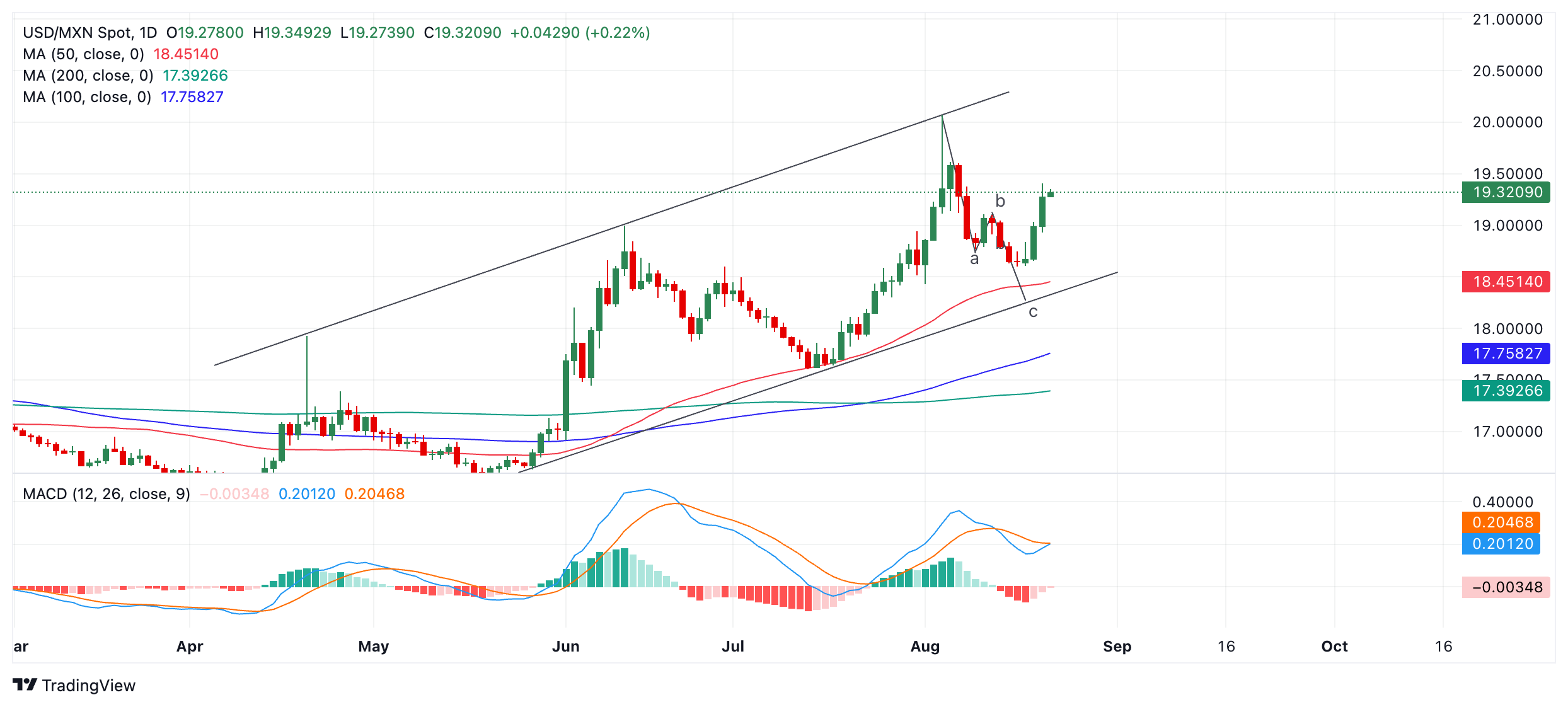Mexican Peso extends decline after release of UK and Eurozone PMI data

- The Mexican Peso is depreciating in its key pairs ahead of the release of key data on Thursday.
- Mexican inflation and GDP data could provide volatility, whilst flash PMIs in Europe and the US could influence counterparts.
- USD/MXN shrugged off negative economic news from the US and continued rising on Wednesday.
The Mexican Peso (MXN) extends losses in its key pairs on Thursday. The decline broadens the trend of the last few days, which has seen MXN lose 1.50% to 1.90% on Wednesday after a similar decline on Tuesday.
Traders now await potentially market-moving data out of both Mexico and Europe on Thursday, and prepare for Federal Reserve (Fed) Chairman Jerome Powell’s speech at Jackson Hole on Friday.
EUR/MXN has fallen back slightly after the release of preliminary German Purchasing Manager Index (PMI) data for August which measures activity in major industry sectors. The data came out lower-than-expected for Composite, Manufacturing and Services PMIs, suggesting a slowdown in Europe’s largest economy.
The negative German data was partly offset by Eurozone HCOB PMIs, however, which revealed more mixed results.
The Eurozone HCOB Composite PMI rose to 51.2 in August from 50.2 in July when a decline to 50.1 had been expected. HCOB Manufacturing PMI fell to 45.6 from 45.8 when no-change had been forecast. Services PMI casme out at 53.3 from 51.9 when no-change had been forecast.
GBP/MXN gets a slight lift, meanwhile, from UK S&P Global/CIPS PMI data which beat expectations for Composite, Services and Manufacturing sectors.
At the time of writing, one US Dollar (USD) buys 19.30 Mexican Pesos, EUR/MXN trades at 21.51, and GBP/MXN at 25.30.
Mexican Peso weakens against USD despite weak US data
The Mexican Peso’s 1.50% fall against the US Dollar (USD) on Wednesday came about despite the release of broadly negative Bureau of Labour Statistics (BLS) revisions to Nonfarm Payrolls and the US Federal Reserve’s (Fed) July meeting Minutes, which revealed policymakers are more open to cutting interest rates. The expectation of lower interest rates is generally negative for a currency as it reduces foreign capital inflows.
The US Bureau of Labour Statistics (BLS) released their revisions for Nonfarm Payrolls in the year to March 2024 and these showed an aggregate downward revision of 818,000 to payrolls for the previous 12 months, which translates to an average of 68,000 per month. This is likely to add to concerns regarding the health of the US labor market and the US economy experiencing a hard landing. This is especially the case in light of the “flash crash” that followed the release of a weak July NFP number, which came out below expectations at 114,000, whilst the US Unemployment Rate edged up another notch to 4.3%.
Although the US Dollar outperformed the Peso, the US Dollar Index (DXY) – which tracks the value of the Dollar against a trade-weighted basket of counterparts – did hit a new year-to-date low during the Asian session on Wednesday before rebounding, prior to the release of the weak BLS data and the Fed Minutes.
Data on the horizon
Thursday sees the release of more data for the Peso and its pairs.
Mexican 1st Half-Month Inflation for August and Q2 Gross Domestic Product (GDP) data will be published by INEGI at 12.00 GMT. Followed by the Minutes from the Banco de Mexico’s (Banxico) August policy meeting.
US Preliminary Purchasing Manager Indexes (PMI) for August will be released at 13:45 GMT.
Eurozone wage negotiations data will also be released at 9:00 GMT on Thursday, and could color the outlook for inflation in the region. This in turn could influence the trajectory of monetary policy by the European Central Bank (ECB) with implications for the Euro (EUR) and EUR/MXN.
Technical Analysis: USD/MXN extends new leg higher
USD/MXN extends its gains, further reversing the prior evolving down leg within the pair’s broader rising channel.
The long green up days posted on Tuesday and Wednesday could indicate the short-term trend is changing and the pair may be about to begin a new up leg within the channel.
USD/MXN Daily Chart
USD/MXN had been looking like it was unfolding in a bearish abc pattern within its rising channel, however, wave “c” has failed to extend all the way down to the lower channel line.
The pair has also now broken above the top of wave “b” at 19.10, tilting the odds in favor of bulls. The break could indicate a stronger up move is underway, that could take the pair back up to the channel highs at roughly 20.50.
The overall trend on the medium and longer-term time frames is arguably up, suggesting a bullish backdrop that provides extra support to the view that a new upward move is underway.
Economic Indicator
HCOB Composite PMI
The Composite Purchasing Managers’ Index (PMI), released on a monthly basis by S&P Global and Hamburg Commercial Bank (HCOB), is a leading indicator gauging private-business activity in the Eurozone for both the manufacturing and services sectors. The data is derived from surveys to senior executives. Each response is weighted according to the size of the company and its contribution to total manufacturing or services output accounted for by the sub-sector to which that company belongs. Survey responses reflect the change, if any, in the current month compared to the previous month and can anticipate changing trends in official data series such as Gross Domestic Product (GDP), industrial production, employment and inflation. The index varies between 0 and 100, with levels of 50.0 signaling no change over the previous month. A reading above 50 indicates that the private economy is generally expanding, a bullish sign for the Euro (EUR). Meanwhile, a reading below 50 signals that activity is generally declining, which is seen as bearish for EUR.
Last release: Thu Aug 22, 2024 08:00 (Prel)
Frequency: Monthly
Actual: 51.2
Consensus: 50.1
Previous: 50.2
Source: S&P Global
